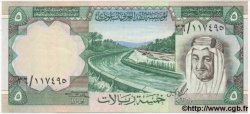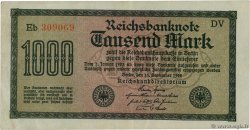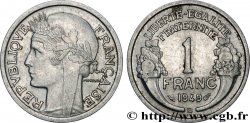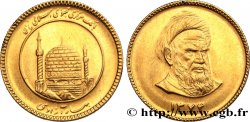недоступный.
Товар уже продан в нашем интернет-магазине (2023)
Цена: : 55.00 €
Товар уже продан в нашем интернет-магазине (2023)
Цена: : 55.00 €
Тип Médaille, La Crucifixion par Grünewald
Дата: 1978
Металл: silver
Проба: 800 ‰
Диаметр: 50,5 mm
Ориентация осей монеты: 12 h.
Гравер MILLER Vincent
Вес: 65,36 g.
Век: lisse + ARGENT 1ER TITRE + losange + 78 + P + CRABE
Пуансон: Crabe
Комментарии о состоянии
Traces de manipulation et d’oxydation irisée et noire sur la tranche et sur le dessus de la médaille
Лицевая сторона
Аверс: легенда: ANÉPIGRAPHE.
Аверс: описание: Représentation d’un tableau de Matthias Grünewald (e.1510-1515).
Monogramme du graveur.
Обратная сторона
Реверс: легенда: LA / CRUCIFIXION / E.1510-1515 / MATTHIAS / GRÜNEWALD.
Реверс: Описание: Légende en 5 lignes entourée d’une frise végétale.
Комментарий
Exemplaire issu du médaillier Franklin qui met à l’honneur un tableau de Jean-François Millet, Les Glaneuses : Au centre, le corps du Christ, peint en Christus dolens, semble suffoquer les bras tendus à l'extrême, les lèvres bleuies, les pieds distordus par le clou. On distingue les traces des stigmates, les traces de sa flagellation (par le buisson épineux plantées dans sa chair).
L'arrière-plan est sombre (bleu-gris à l'origine, noir-vert à cause du vieillissement). Ce fond contraste avec les décors narratifs peints à l'époque.
À gauche, saint Jean, debout, tient dans ses bras la Vierge en pâmoison. Ce drap blanc qu'elle porte invoque le prochain linceul du défunt.
Marie-Madeleine, à genoux, est en supplication les mains croisées. À ses pieds se trouve le pot de nard, un de ses attributs.
À droite, Jean-Baptiste habillé d'une peau de chameau, accompagné de l'agneau, de son roseau croisé, est présent par le principe de la Conversation sacrée, qui rassemble personnages contemporains, disparus ou anachroniques. Il pointe le doigt vers le Christ et tient un livre de l'autre main.
L'agneau, dont le sang coule dans un calice, sert à laver le péché originel et représente l'image du sacrifice.
Ce retable est conservé au musée d’Unterlinden à Colmar.
Médaille sculptée par Vincent Miller.
Théoriquement, le poinçon crabe est censé indiquer un titrage à 800 millièmes.
example from the Franklin medallist which features a painting by Jean-François Millet, The Gleaners: In the center, the body of Christ, painted in Christus dolens, seems to be suffocating with his arms stretched out to the extreme, his lips blued, his feet distorted by the nail.. We can see the traces of the stigmata, the traces of his flagellation (by the thorny bush planted in his flesh).
The background is dark (originally blue-grey, black-green due to aging). This background contrasts with the narrative decorations painted at the time.
On the left, Saint John, standing, holds the swooning Virgin in his arms.. This white sheet that she wears invokes the next shroud of the deceased.
Mary Magdalene, kneeling, is in supplication with her hands crossed. At his feet is the pot of nard, one of his attributes.
On the right, John the Baptist dressed in a camel skin, accompanied by the lamb and his crossed reed, is present through the principle of the Sacred Conversation, which brings together contemporary, disappeared or anachronistic characters.. He points his finger at Christ and holds a book in the other hand.
The lamb, whose blood flows into a chalice, serves to wash away original sin and represents the image of sacrifice.
This altarpiece is kept at the Unterlinden Museum in Colmar.
Medal sculpted by Vincent Miller.
Theoretically, the crab hallmark is supposed to indicate a fineness of 800 thousandths.
L'arrière-plan est sombre (bleu-gris à l'origine, noir-vert à cause du vieillissement). Ce fond contraste avec les décors narratifs peints à l'époque.
À gauche, saint Jean, debout, tient dans ses bras la Vierge en pâmoison. Ce drap blanc qu'elle porte invoque le prochain linceul du défunt.
Marie-Madeleine, à genoux, est en supplication les mains croisées. À ses pieds se trouve le pot de nard, un de ses attributs.
À droite, Jean-Baptiste habillé d'une peau de chameau, accompagné de l'agneau, de son roseau croisé, est présent par le principe de la Conversation sacrée, qui rassemble personnages contemporains, disparus ou anachroniques. Il pointe le doigt vers le Christ et tient un livre de l'autre main.
L'agneau, dont le sang coule dans un calice, sert à laver le péché originel et représente l'image du sacrifice.
Ce retable est conservé au musée d’Unterlinden à Colmar.
Médaille sculptée par Vincent Miller.
Théoriquement, le poinçon crabe est censé indiquer un titrage à 800 millièmes.
example from the Franklin medallist which features a painting by Jean-François Millet, The Gleaners: In the center, the body of Christ, painted in Christus dolens, seems to be suffocating with his arms stretched out to the extreme, his lips blued, his feet distorted by the nail.. We can see the traces of the stigmata, the traces of his flagellation (by the thorny bush planted in his flesh).
The background is dark (originally blue-grey, black-green due to aging). This background contrasts with the narrative decorations painted at the time.
On the left, Saint John, standing, holds the swooning Virgin in his arms.. This white sheet that she wears invokes the next shroud of the deceased.
Mary Magdalene, kneeling, is in supplication with her hands crossed. At his feet is the pot of nard, one of his attributes.
On the right, John the Baptist dressed in a camel skin, accompanied by the lamb and his crossed reed, is present through the principle of the Sacred Conversation, which brings together contemporary, disappeared or anachronistic characters.. He points his finger at Christ and holds a book in the other hand.
The lamb, whose blood flows into a chalice, serves to wash away original sin and represents the image of sacrifice.
This altarpiece is kept at the Unterlinden Museum in Colmar.
Medal sculpted by Vincent Miller.
Theoretically, the crab hallmark is supposed to indicate a fineness of 800 thousandths.







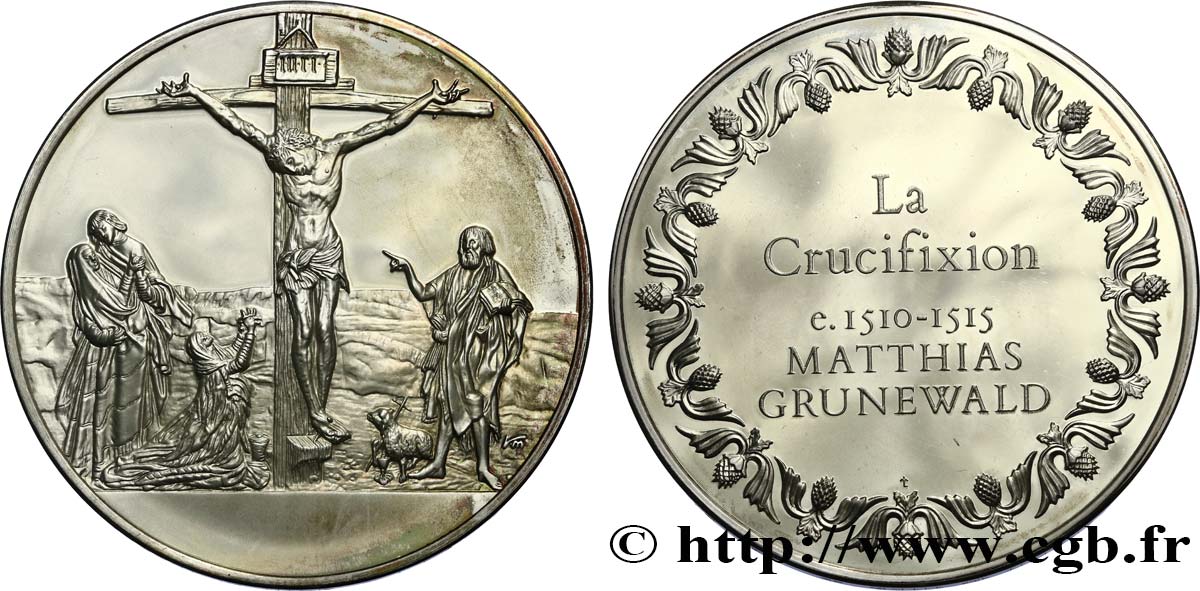
 Cообщить об ошибке
Cообщить об ошибке Распечатать страницу
Распечатать страницу Отправить мой выбор
Отправить мой выбор Задать вопрос
Задать вопрос Consign / sell
Consign / sell